Linkfest #36: Moon Rice, Mountaineering in High Heels, and Why Birds Never Debate Economic Policy
Hello folks!
It’s time for "the opposite of doomscrolling” — my next Linkfest, in which I scavenge through the thrift shops of the aer’y internet, looking for neglected finds in science, culture, and technology.
If you’re a subscriber, thank you! If not, you can sign up here — it’s a Guardian-style, pay-whatevs-you-want affair; the folks who kick in help keep the Linkfest free for everyone else.
And: Please share this email with anyone who'd enjoy it.
Let’s begin ...
1) 👠 Hiking Colorado’s mountains in high heels

Colorado has 58 mountains that qualify as “14ers” — i.e. they’re 14,000 feet or higher. People come from all over the world to hike them.
But only Erin Ton is doing it in a dress and heels. She’d hiked all the 14ers using regular hiking gear, but then got the idea to do it using footwear that would seem to be rather less practical.
Is it, though? As Teaghan Skulszki reports in Outside …
The heel thing started well before that, though, as a joke between Ton and her friends. They hypothesized that the leverage of a high heel could help counteract the incline of a steep slope, alleviating strain on the feet. Theoretically, it would be similar to using a heel riser while backcountry skiing, or a trail shoe with a very, very high midsole drop. In 2020, Ton put this hypothesis to the test, paying homage to her first ascent of Mount Elbert by doing it again—but this time in high heels.
Ton has also found that her hikes — which, as you’d imagine, go viral on social media — have jolted a lot of women into thinking wait, hold it, maybe I should try hiking …
“I’ve had numerous women reach out to me saying it’s inspired them to wear what they want in the outdoors. All too often, women are siloed into one category, but being outdoorsy and feminine aren’t mutually exclusive,” she explained.
As for the original hypothesis, that heels might be advantageous in mountaineering? That’s less the case. Ton thinks the heels have strengthened her lower legs, but they’ve also caused a lot of blisters.
2) 🦈 “Jaws”, the text adventure

It’s the 50th anniversary of Jaws, so I watched it last week with my wife. She’d never seen it all the way through. We both agreed that it holds up: Terrific acting, briskly plotted, and frequently funny in a way I’d forgotten, since I hadn’t rewatched the movie since the early 00s.
Today I discovered that the programmer and designer Matt Round had created a cheeky text adventure based on Jaws, for the now-defunct site UsVsTh3m. It’s now hosted on his personal site, so you can play it there.
It’s almost worth rewatching the movie before you play the game, though, because Round duplicates the movie scenes quite neatly — except now you experience them as the shark, in text. Like so:
You are near a beach packed with holidaymakers. They look so happy. A black DOG is paddling with a stick in its mouth, and there's a young BOY on an inflatable. The south-west corner of the island is to the SOUTH.
The shark’s internal monologue as it devours people is pretty excellent.
3) 💻 Apple’s first Macintosh team fought over desktop-pattern customization
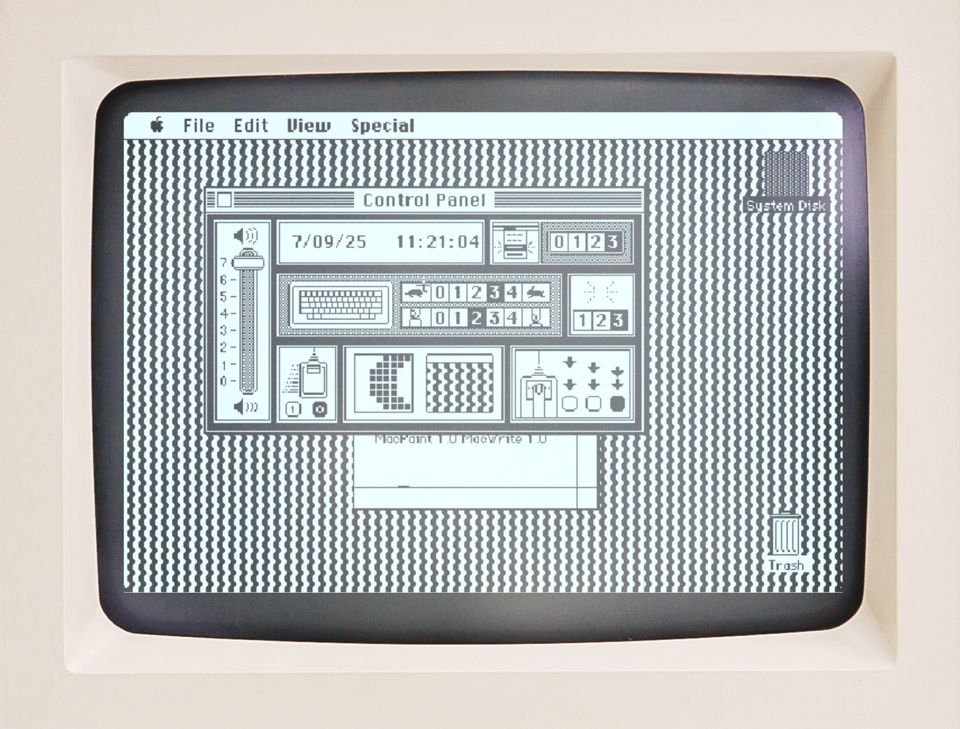
If you’re old enough to remember the first-ever 1984 Macintosh computers, you probably also remember that the control panel introduced a fun new past-time: You could customize your background.
See that control panel above? The option in the bottom middle has a clickable 8×8 grid of pixels; create one design, and it would be tiled across the entire desktop.
The designer Marcin Wichary has written a deep dive into the history of Mac control-panels and settings, and it is wildly engrossing. He begins with that first 1984 Mac, which had the first-ever Apple control system:
The Control Panel is a handsome and tight design, put together by Susan Kare as the last desk accessory, just weeks before the Mac’s announcement. It feels alive, depicting a perhaps surprising amount of movement sometimes via animation, and sometimes via comic book-inspired conventions: soundwaves exiting the speaker, menus blinking upon activation, a finger pressing a key, the mouse rolling on the desk. It’s also a playground of sorts for early GUI experiments: there is an early slider here, some steppers for date and time, a custom cursor, and a mini map showing a miniature desktop.
The ability to customize one’s desktop, though? It bitterly divided the early Mac team:
The original Mac team was divided on this one, worrying this would lead to “abominable patterns” and therefore “ugly desktops” – an ongoing design challenge for any setting that is not about how something works, but about how something looks.
Future, more garish desktop options on computers and eventually smartphones would render these early reservations quaint. This might be the best that the Mac desktop will look for about the next twenty years. But at this moment, it felt serious. The creator of MacPaint rebelled and built his app so that any custom background would be drawn over by a default 50% checkerboard anyway. But can you even make an ugly desktop pattern with just 64 black pixels to mess with? Maybe… The most surprising is the fact that the team also prepared 41 beautiful built-in patterns, but hid them inside this control panel with the only hints how to get them appearing in the manual.
BTW, Marcin’s essay has amazing high-tech enhancements. The engineer Mihai Parparita embedded emulators to ten different Macs, from 1984 to 2002 — so as you read Marcin’s analysis, you can also click around inside the computers, open apps, and explore the twisty evolution of the control panels themselves. The desktop pattern you see above? I made it myself, using the emulator for the 1984 Mac.
This is an amazing work of digital history — an absolute blast to read, but also fun to play with.
4) 🎋 The bamboo scaffolds of Hong Kong

In most cities, if a construction firm does work on a building, they’ll erect scaffolding — which will, bien sur, be made of metal.
Not in Hong Kong. They have an old tradition of using bamboo to build scaffolding, and a subculture of scaffold-makers who know the elite art of crafting towering structures out of these natural materials.
Tiffany May wrote a fascinating piece about the scene …
Lattices of bamboo poles bound together by intricate knots regularly rise across the city to build and renovate apartment blocks and commercial skyscrapers that can be dozens of stories high.
Advocates of the material, including Ms. Pak, say it is lighter and cheaper than metal to transport and carry in Hong Kong’s tight urban spaces. Builders particularly favor the material when erecting platforms that support workers who patch up building exteriors and replace old pipes and window sills. [snip]
For metal scaffolding, engineers can make decisions such as how thick a pole to use and how far apart to space the ringlocks based on calculations accounting for load and extreme weather, Mr. Za said. But that cannot be done for bamboo scaffolds, because the poles do not come in uniform shapes, requiring the discretion of bamboo masters. [snip]
But [Daisy Pak’s] love for bamboo, bordering on sentimentality, has only grown. “The material is so dynamic and resilient,” she said. “It’s just like the spirit of Hong Kong.”
Really engrossing stuff, and the story has wonderful photography (that pic above is from Flickr, not from the story itself); you can read it via this gift link.
5) 😎 AR glasses that block ads in the world around you

Stijn Spanhove took a pair of Snap’s augmented-reality goggles and used image-recognition to identify ads and brands — then block them with a red bar.
On X, he posted a video of it working its magic on street signs, soda cans, and even newspapers.
It’s pretty hilarious. In the thread that ensured, people suggested that instead of replacing ads/brands with red squares, he insert soothing vistas of nature. One wit also suggested he insert your “to do list”, which would be nicely dystopic.
6) 🚣 Crossing the Pacific in a Paleolithic dugout canoe

Archaeologists were surprised when they first discovered the remains of Paleolithic societies on islands in the remote Pacific. These islands were hundreds of miles off the coast of modern-day Japan, Taiwan and China, and those ocean passages have ferocious currents. How the heck did our ancestors do it, tens of thousands of years ago?
Possibly by using dugout canoes, which are robust enough to withstand the oceans, yet build-able using stone-age axes. To test this hypothesis, a group of scholars from Japan and Taiwan recently built their own dugout canoe — using period-appropriate stone tools — and took it on a grueling 45-hour voyage. They didn’t use any GPS or compass; they’d have to navigate by sight alone.
As Jennifer Ouellette reports in Ars Technica …
It took six days to cut down a Japanese cedar tree with replica edge-ground stone axes … They polished the outer and inner surfaces with fire and stone and nicknamed the completed dugout "Sugime." They also installed crude wooden seats to make the crew more comfortable.
For the test voyage, Kaifu et al. selected the Ryukyus strait between Taiwan and Yonaguni Island, where there are no effective tailwinds, the Kuroshio current flows northward, and the target island is not visible for more than the first half of the voyage, limiting its usefulness for navigation. They recruited a team of five experienced paddlers to make what turned out to be a grueling 45-hour voyage.
When the paddlers encountered choppy sea conditions, they noted that the canoe tended to rotate northward. And they learned to keep an eye out for large waves inbound from the north, temporarily turning the bow northward to ride them out. There was little rest for the paddlers in order to keep the boat from capsizing on the first day, and by the second, the crew was tired, sleep-deprived, very hot, and uncertain about their precise position since the target island was not yet in sight. They experienced stomach cramps, abdominal muscle pain, and even hallucinations, but they persevered.
This was their route …
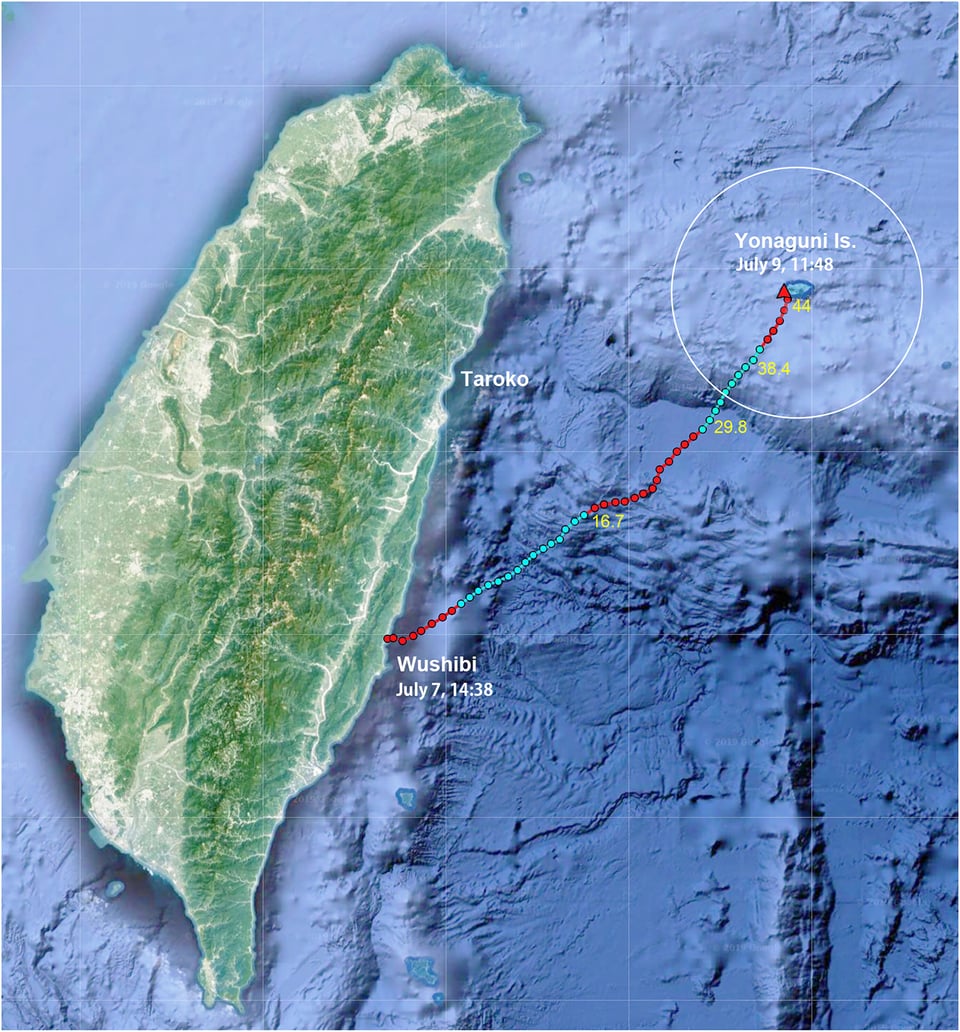
Not comfortable, but a pretty cool way to test an historical idea. You can read the academic paper here for free. There’s also a six-minute Youtube video about the trip, and a 1.5-hour documentary.
7) 🧮 Turing-complete mechanical computer kit

I usually hesitate to share cool-looking Kickstarter campaigns, because they don’t always work out. But this one so precisely occupies the Venn overlap of all my Linkfest obsessions that I couldn’t leave it un-linked-to.
Behold “roons”, a mechanical computer that you program by assembling tiny bricks — each of which has a directionality — and then putting little balls on the bricks, which become the program’s data. When you turn the computer’s gears, the bricks rise and fall, moving the balls along … and thus computing your answer.
roons is a kit for building mechanical computers -- think "Minecraft redstone in real life". (This is a comparison only; we're not affiliated with Minecraft!)
Combine logic gates and memory blocks to invent your own devices — transistors, processors, and even fully programmable computers.
roons is Turing complete, meaning you can build any kind of computer circuit.
The pricing isn’t too extreme, so I am thinking of ordering a kit. Their ship date is February 2026.
8) 🎨 Optical-telegraph towers in French 19th-century art
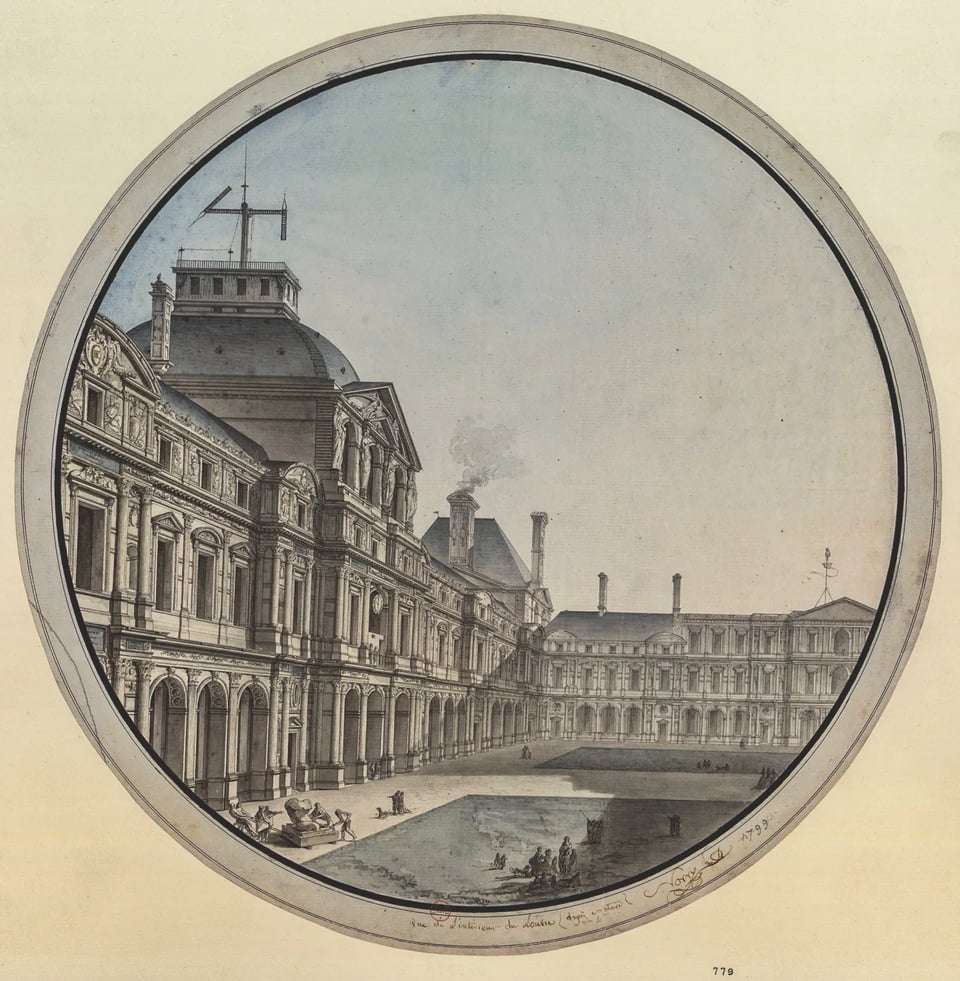
Before the electric telegraph was invented, France rolled out a ton of “optical telegraph towers”. They were devices that had two rotating sticks that you’d spin, using semaphore to spell out letters and numbers that could be seen for (ideally) a few miles. The engineer Claude Chappe debuted his design in 1792, and by the 19th century the country had over 560 of them, blasting messages around the countryside.
Petrified by the unknown, Parisians smashed an early version in 1792. Politicians were suspicious of what the author calls “mechanical monsters, secretive and strange,” in the aftermath of the French Revolution. And this “angular and winged” device’s aesthetic or grotesque figurative possibilities either enchanted or perturbed artists of the era. Even Victor Hugo did not hold back. Of the telegraph that was then mounted atop the Parisian cathedral Saint-Sulpice, the Romantic author writes in his 1819 anti-Napoleon satirical poem “Le Télégraphe”: “There, before my window! It is quite ridiculous / That someone would place a telegraph outside my room!”
Visual artists, though, were quite mesmerized by them. These strange, alien structures with revolving robotic arms — they looked so technological, compared to the historic buildings on which they were mounted! So artists frequently depicted telegraph towers in paintings, such as Charles Norry’s 1799 “View of the interior of the Louvre from nature in the 4th year”, above.
You can see two other artworks that include telegraph towers if you visit that blog post at Hyperallergic. Also, Richard Taws has written a book about optical telegraphs — Time Machines — which apparently includes many more images.
9) ✍️ Literature made for the web browser
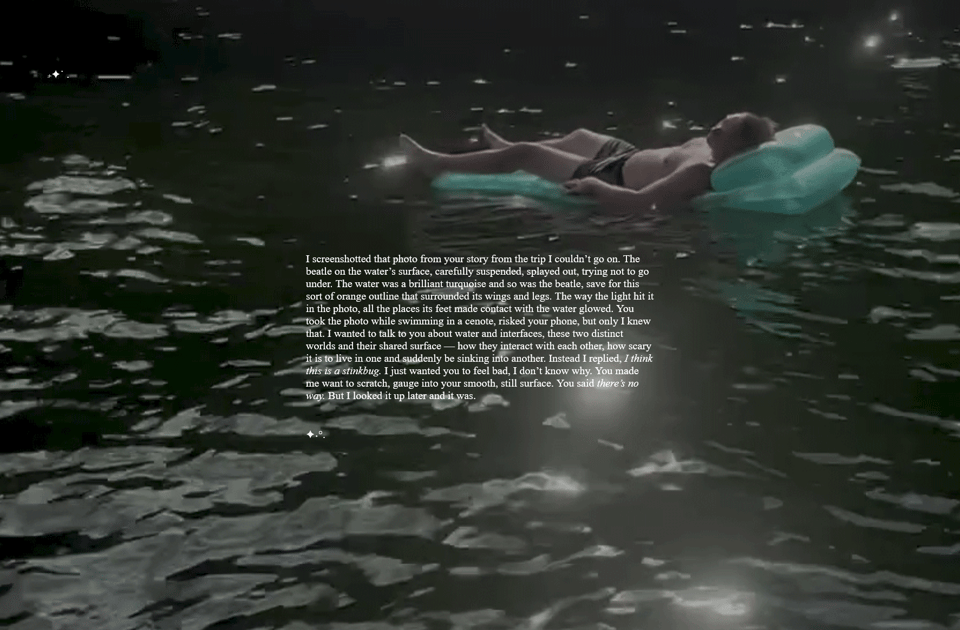
I just stumbled across The HTML Review, which bills itself as “an annual journal of literature made to exist on the web.”
It’s digital lit where the authors use the multimedia-and-code-slinging nature of the browser as part of the warp and woof of the art. It reminds me of some of the digital art that got made back in the late 90s and early 00s; that was the period when the browserness of browsers was still novel enough that we remarked up on it, noticed it, as an addition to our mediated landscape. These artists are rediscovering the strange pleasures of writing for the browser.
That picture above is a screenshot from “A Shimmering”, a series of lovely prose poems by Meg Miller and Mariah Barden Jones, which are set against looping low-fi animated gifs with water themes. (Screenshot above.) Another interesting piece is “Airs”, a set of poems rendered in a distressed font and set to moody audio of rising and falling wind.
I particularly dug Blair Johnson’s “Spoilia”, a poem that renders a bunch of rasterized boulders on top of the text of the poetry. To read it, you have to keep pushing the boulders out of the way, and they keep falling back down to obscure your view. It makes the act of reading faintly annoying, in an aesthetically hilarious fashion. The design of the boulders reminds me of the asteroids in the eponymous 1979 video game, a literary ancestry that I’m betting is intentional, heh.
10) 🚀 Navigating deep space using the changing position of stars

The New Horizons space probe is 9,151,139,138 km away from Earth, which is so far that — from the probe’s point of view — the nearest stars have shifted their position.
Above is an animated gif that shows Proxima Centauri, as viewed in a photo from Earth vs. a photo taken by New Horizons. The star shifts place depending on where you’re looking at it from.
Give the probe a couple more million years of travel? It’ll be so much further from Earth that entire constellations might be shaped differently. Thank you, space exploration, for giving us this whoa-dude epiphany about the subjective nature of celestial phenomena!
But the parallax behavior of stars is also, as NASA points out, useful for navigation when you’re in truly deep, deep space. Right now, we use radio signals blasted from Earth to figure out where a probe is. But if you got really far out there? The radio signals would be so uselessly distant that a probe would need to figure out its location on its own … by looking to the stars, just like a 16th-century vessel crossing the Atlantic.
To prove this could work, an international team of astronomers used some 2020 pictures that New Horizons took of the star field, and used the parallax changes to calculate its location. It worked! Though it was pretty crude:
… the parallax method was far less accurate, locating New Horizons within a sphere with a radius of 60 million kilometres, about half the distance between Earth and the sun.
“We’re not going to put the Deep Space Network out of business – this is only a demo proof of concept,” says Lauer. However, with a better camera and equipment they could improve the accuracy by up to 100 times, he says. Using this technique for interstellar navigation could offer advantages over the DSN because it could give more accurate location readings as a spacecraft gets further away from Earth, as well as being able to operate autonomously without needing to wait for a radio signal to come from our solar system, says Massimiliano Vasile at the University of Strathclyde, UK.
“If you travel to an actual star, we are talking about light years,” says Vasile. “What happens is that your signal from the Deep Space Network has to travel all the way there and then all the way back, and it’s travelling at the speed of light, so it takes years.”
There’s more at that New Scientist story, above, by Alex Wilkins, and you can also read the scientific paper for free here. Oh and: A 2020 story with more parallax pics taken by New Horizons.
11) 👗 A cathedral dress

This is superb: Instructions on how to create a skirt with stained-style see-through sections and internal LED lighting, such that it looks like you’re wearing a cathedral.
It was designed by Christina Ernst, a software and hardware engineer. As she writes in her build instructions …
Go for vibrant, jewel-toned fabrics — they pop the most when illuminated from behind. And choose bulb LED strips to flat ones; the light will project up into the whole window instead of out. [snip]
This dress looks and photographs best after sunset or in near darkness.
BTW, Ernst also runs She Builds Robots, which offers instructions on building several very fun hardware projects, such as this ‘lil teabot that steeps tea for you by swishing the teabag around and pulling it out when the tea is ready. Below …

I am totally building one of these this weekend!
12) 🐤 Why don’t birds have culture?

Antone Martinho-Truswell is an evolutionary biologist who has recently been wondering: Why haven’t birds ever developed transmissible culture?
Humans have developed a ton of transmissible culture — knowledge we hand on to our kids, and them to theirs. It’s how we’ve come to dominate the planet, for better and for worse.
The thing is, as he points out, while birds don’t create transmissible culture, they certainly could. They’ve got many of the same physical/intellectual gifts that humans have, because …
… they already come with several of the important adaptations that made cultural sharing possible for us: complex brains, long lives, strong parental care of offspring in most species, and robust communication. With all of those advantages, why don’t birds have complex culture like we do? Why do they not write technical manuals and make art and argue over economic policy? Why do they not have a market economy, with not only goods for trade, but luxury goods whose value relies on concepts rather than raw usefulness?
In this long and fascinating essay, he proposes a simple explanation: Birds can fly, and flight made life so easy for them that they never had to evolve towards transmissible culture …
Flight is an incredible adaptation. It opens an entire third dimension of free movement to species capable of flying. First and foremost, this is game-changing for a prey animal. Being able to escape a predator by travelling in a direction the predator is incapable of going, namely, up, is a huge selection advantage. A flying animal is at risk of consistent predation only from other flying animals, which are fundamentally rare. Moreover, flight limits size and weight, so a bird at the higher end of the flying spectrum is unlikely to have many flying predators large enough to cause her much of a problem.
The reduced risk of predation is in turn why birds live so long. It creates a virtuous cycle where each subsequent year of the bird’s life has a higher potential reproductive value than it would if they didn’t fly, which in turn drives the evolution of robust repair mechanisms in the body, of slower but more attentive reproductive strategies, and of a longer natural lifespan. Together, these are a suite of traits that biologists call ‘K-selected’ – basically, the ‘live slow, die old’ strategy.
Flight also provides access to resources not available to the landbound. All manner of food sources and safe habitats become available when an animal can fly – from tall flowering trees’ nectar and fruits, to inaccessible cliffside perches, to stronghold-like tree hollows for nesting. It opens up completely vacant niches that can be exploited only by fellow flying species.
All of this is to say that evolving the ability to fly removes a huge amount of selection pressure from the species that have it. It makes life easier. It is itself a deep, low well in the evolutionary landscape. It is a very, very massive gravitational object pulling in species and keeping them in its sphere.
This is a really fun essay — long, but well worth reading because of how he breaks down the question of how evolutionary breakthrough are propelled. It’s not a watertight argument, and it’s unprovable; but it’s enjoyable to ponder.
13) ⌨️ The Backrooms, done entirely in CSS
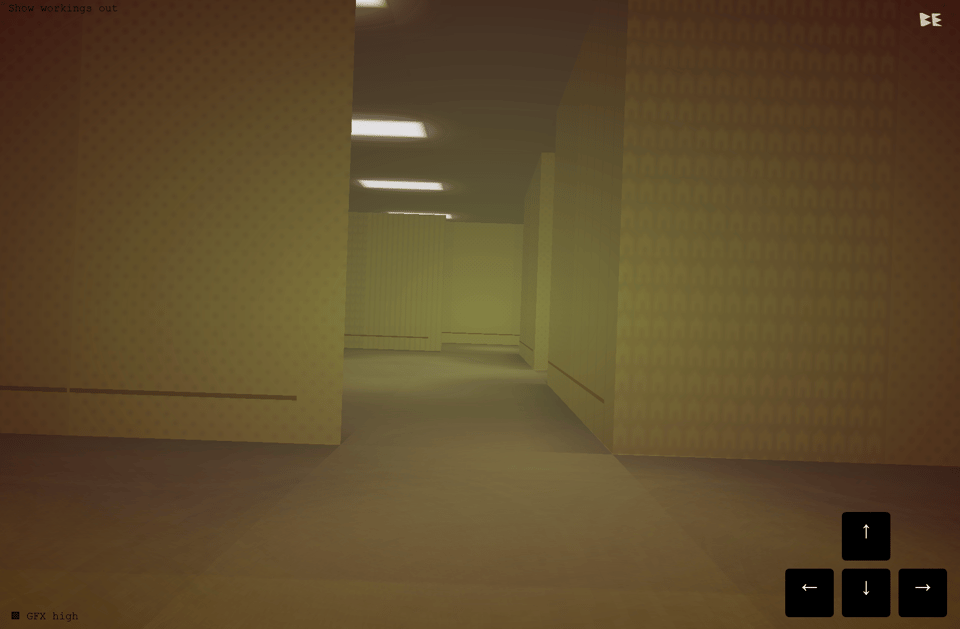
Ben Evans calls himself a “CSS Artist”, and I can find no way to disagree — because he just released an interactive version of the Backrooms coded entirely in CSS.
Well, almost entirely in CSS. As he notes in his code comments, there is “the teeny-tiniest amount of JavaScript required to play sound” … and of course you need the sound of buzzing office-park fluorescent lights if you really wanna experience the Backrooms.
He also adds, in the comments …
// WARNING! Playing on Safari may result in actual noclip!
LOL. BTW in case you have no idea what the heck the Backrooms are, the Wikipedia page is pretty good, though watching this YouTube web series is even better.
Oh, and: Evans had previously released a 3D immersive maze done entirely in CSS, which, when you look at it now, is clearly what inspired him to reskin it as the Backrooms. I dig how coding projects carry the same sort of descent/ascent/influence as do traditional literary works.
14) 💀 The recurrence of technology-induced spiritual freakouts
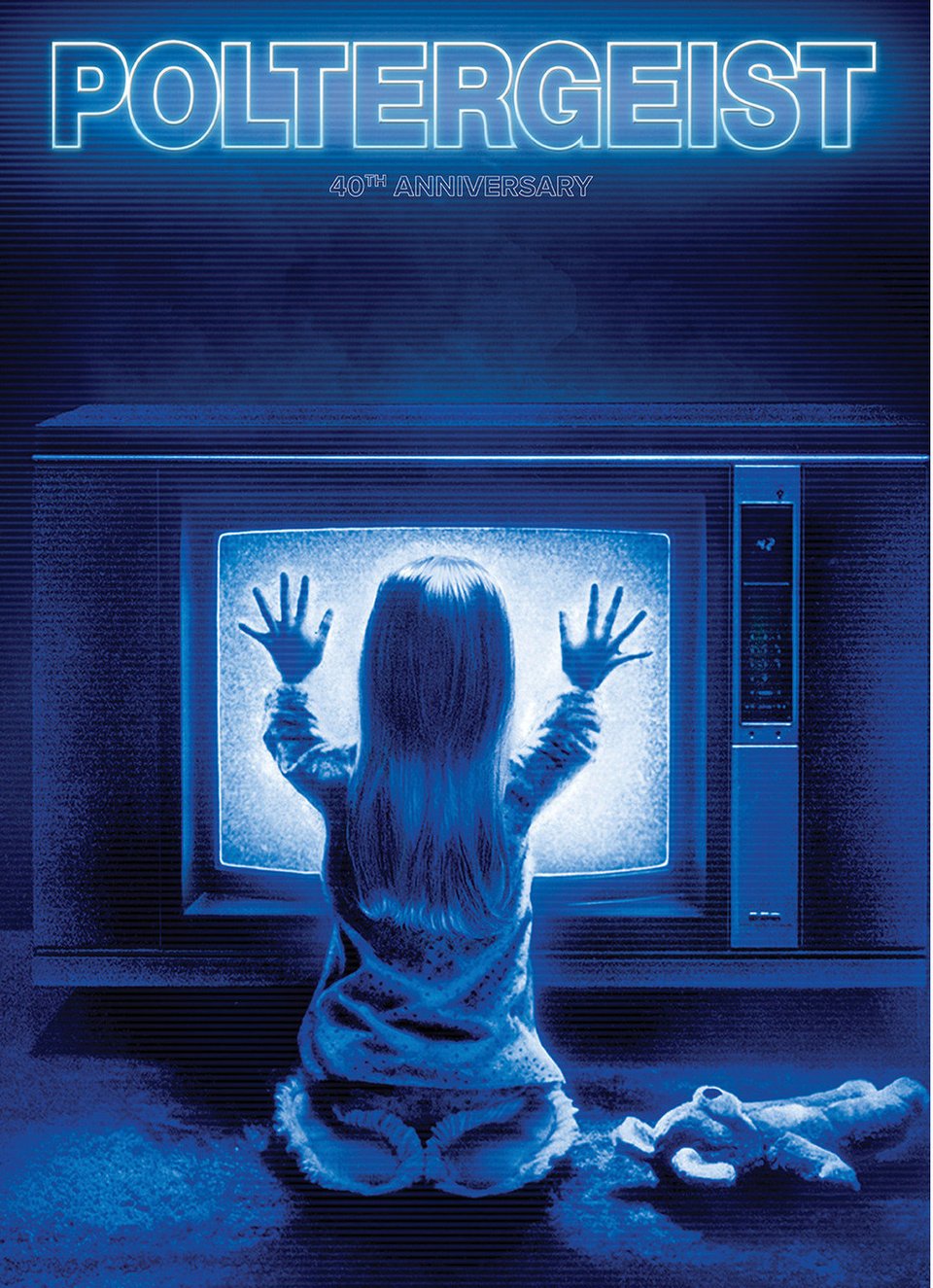
Recently Kashmir Hill published an intriguing piece about people who’d become unhinged from reality after talking to ChatGPT. They’d asked the bot about the nature of reality; ChatGPT offered conspiratorial rants about reality being a Matrix-like illusion, or suggestions about how to tap into supernatural forces, interdimensional planes, and the like. (Here’s a gift link if you want to read the piece, at the New York Times.)
The story, as you’d imagine, alternately mesmerized and horrified people on social media. But then on her newsletter Katherine Dee pointed out some useful context: Nearly every time a new communications media has come along, it has prompted a spiritual freakout — making some users convinced the new tech can tap them into the overmind, the supernatural world, the noosphere, or what have you.
Twenty-five years ago, media scholar Jeffrey Sconce traced this history in his book Haunted Media, showing how we have consistently linked new communication technologies with the paranormal and esoteric. It’s not a random coincidence or sign that we’re in a “uniquely enchanted” age1 but rather a predictable cultural response, one we’ve been replaying over and over for hundreds of years.
Spiritualist mediums claimed to receive messages from the afterlife through Morse code. These operators saw themselves as human receivers, bridging the material and astral. The technology that sent messages across continents without physical contact made it easy to imagine messages crossing the veil.
Radio seemed to throw every word into what Sconce calls an “etheric ocean,” a limitless and invisible sea where messages bobbed about like bottles adrift. By the late 1920s, the big broadcast companies tried to “net” that ocean with fixed frequencies and scheduling. Sconce writes about how fiction reflected this taming of the radio waves. The wistful romances of amateur “DXers”2 scanning the dial gave way to sinister tales of mass hypnosis, government mind-control rays, and Martians commandeering the airwaves. [snip]
Sconce identified three recurring fantasies that emerge with each new medium: the dream of consciousness escaping the body to travel through broadcast; the belief in autonomous “otherworlds”3 created by the technology itself; and the tendency to see machines as somehow alive or haunted.
I really want to get that book Haunted Media! I heard this same thesis years ago when I was reporting for Smithsonian on the early days of photography in the 19th century — when photomanipulators would produce “spirit photographs” showing people next to a translucent image of a dead relative. They were all fakes, created with double exposures, of course. But people were swept up in the idea that this newfangled technology — photography — could tap into the spirit world.
And Americans were culturally primed to be vulnerable to scam artists proffering high-tech connections to the dead. As scholars pointed out to me, the American populace had just emerged from the Civil War — in which 620,000 died, nearly 2% of the population. The country was flat-out traumatized, and this trauma helped kickstart a decades-long fascinating with spiritualism: Spirit photography, seances, mediums, Ouija boards. Because radio was a weird new technology, “people would hold a piece of wire as an antenna during a seance, thinking it’d help them contact the dead.”
As Dee notes, today’s America has lots of people who feel isolated and disconnected from society, which, historically, is another trigger …
The ghosts in the telegraph weren’t about—or just about—death anxiety; they were about the radically isolated individual suddenly able to communicate across vast distances, needing to believe that communication could transcend even mortality.
Me, I’d add COVID into the mix. A reported 1.1 million Americans have died of it, many in huge and sudden early waves in 2020 and 2021. That’s gotta have had some effect on the country’s technospiritual orientation.
Anyway, go read the essay, it’s fascinating! I’m ordering Haunted Media now.
15) 🪨 Digital interfaces on corroded, analog surfaces
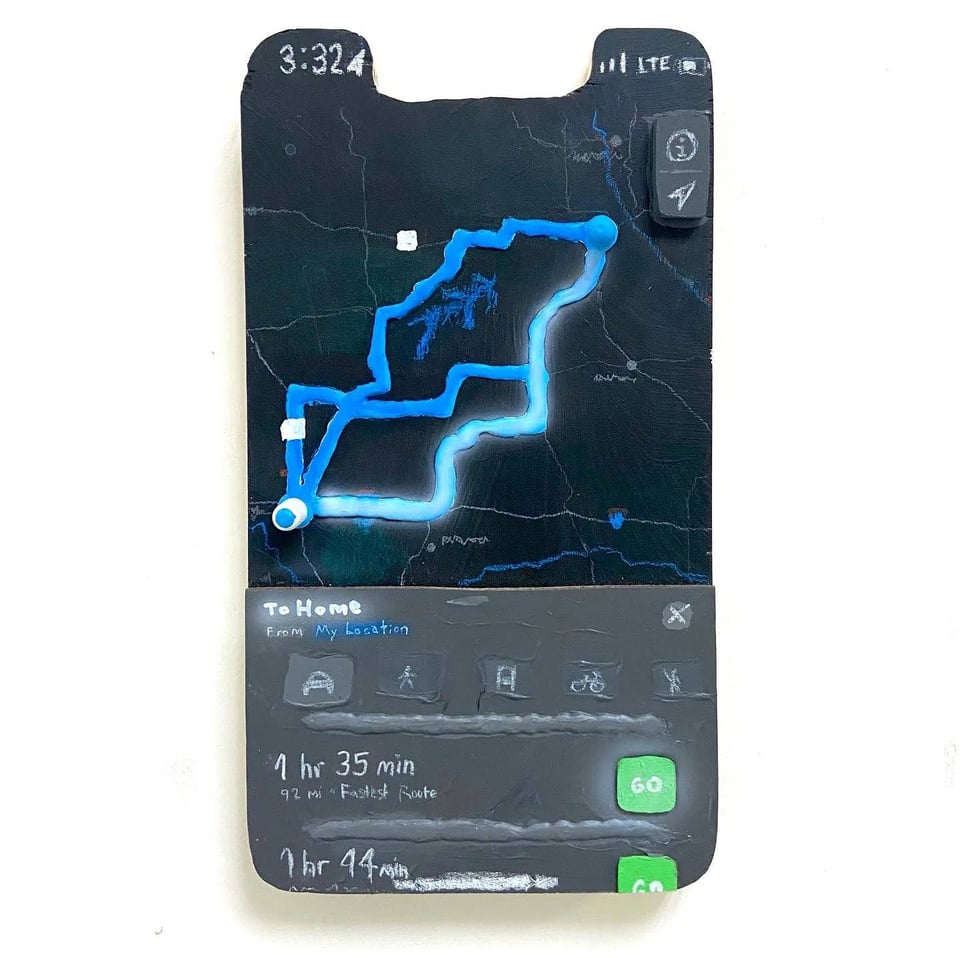
The sculptor Seth Steinman has recently begun a project called “Post-Internet Artifacts”, in which he …
… projects images of the Windows XP start-up screen, Club Penguin, MS Paint and iconic screensavers on hunks of cracked stone – as well as recreations of multiple Safari tabs open with multi-layered wooden sculptures.
The results are like what you see above: The crisp digital interfaces become corroded as they interact with the inherently glitchy flaws of the physical surfaces on which they’re painted.
His version of the Windows XP startup screen is fairly woven from postapocalyptic dread …
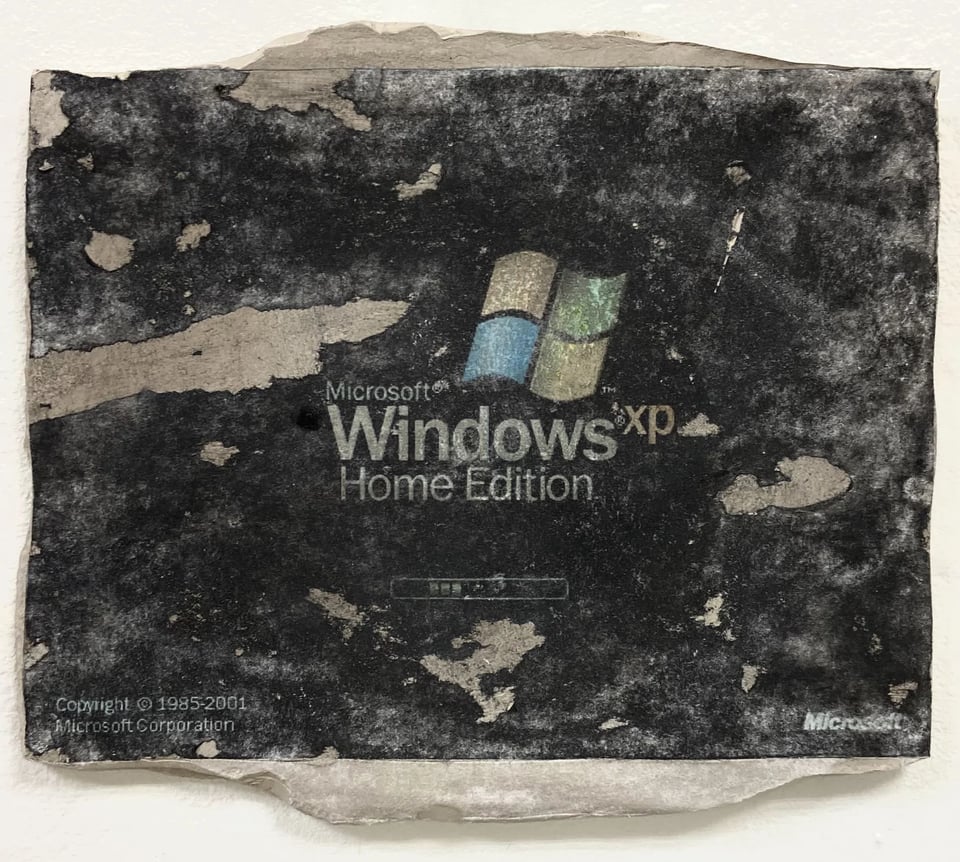
You can check out more of his work via this post at It’s Nice That.
16) 🎡 A final, sudden-death round of reading material
Tattoo-bot. 🎡 Emoji calculator written in COBOL. 🎡 The “am dash”. 🎡 Jailbreaking LLMs with an “infoflood” request. 🎡 The Pentagon Pizza Index. 🎡 Google battles foxes on the roof of its London office. 🎡 The Hubble Tension. 🎡 They finally identified the “scattered man” of New Jersey. 🎡 When John Dryden wrote a rhyming version of Milton’s Paradise Lost. 🎡 The history of electronic music in 476 tracks. 🎡 A hexagon ripple, in CSS. 🎡 What it's like to own flying squirrels. 🎡 A site for recycling your art supplies. 🎡 Buttplug MCP. 🎡 River-mounted solar. 🎡 The evolution of the golf ball. 🎡 2D truchet pattern in WebGL. 🎡 “Hammerscale” evidence that explains where the lost colony of Roanoke vanished. 🎡 Exhaustive review of roast dinners. 🎡 Fractal box-clicker. 🎡 Bitchat. 🎡 Rediscovering “Eric’s Trip”. 🎡 A modern port of Turbo Vision. 🎡 Awesome poetry in Old English that isn’t Beowulf. 🎡 Seizing 5 million smuggled seahorses. 🎡 Database of piano roll music. 🎡 Curbs that charge EVs. 🎡 The Khaybar Oasis. 🎡 Cyborg tadpoles. 🎡 A hardbound edition of the source code for the Macintosh game Glider. 🎡 The oldest known fingerprint is 42,000 years old. 🎡 Why honey doesn’t spoil. 🎡 Tollbit. 🎡 Bicycle-mounted carbon-capture rig. 🎡 Cat chat app. 🎡 Yet more “thundercrow” sightings. 🎡 Open-source Flipper Zero clone. 🎡 Measuring one-quintillionth of a second. 🎡 Underwater turbines. 🎡 Artistic visualization of the 15 types off deadlines. 🎡 The poem “all my friends and i talk about is getting rid of our phones” 🎡 Would a paper plane released from the ISS land safely on Earth? 🎡 Extensive video analysis of the rivers of Hyrule. 🎡 American Glitch. 🎡 Recalculating the calorie-burn of chess grandmasters. 🎡 How Boulder Dash was designed. 🎡 Dumbnote. 🎡 Killer whales craft their own tools. 🎡 You can buy a piece of Mars at auction for $4 million. 🎡 Lab-grown salmon. 🎡 Making a one-handed QWERTY keyboard. 🎡 Give it up, Karlie. 🎡 A perfume-bottle archive. 🎡 A Raspberry Pi vs. a Cray supercomputer. 🎡 Moon rice.
CODA ON SOURCING: I read a ton of blogs and sites every day to find this material. A few I relied on this week include Strange Company, Hackaday, Messy Nessy, The Overspill, Andrew Drucker’s Interesting Links, Numlock News, the Awesomer, the Morning News, and “When The Going Gets Weird”; check ‘em out!